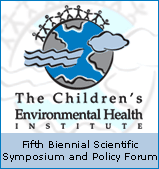| Measurement of Pesticides and Other Toxicants in Amniotic Fluid as a Potential Biomarker of Prenatal Exposure: A Validation Study Asa Bradman,1 Dana B. Barr,2 Birgit G. Claus Henn,1 Timothy Drumheller,3 Cynthia Curry,3 and Brenda Eskenazi1
1Center for Children's Environmental Health Research, School of Public Health, University of California, Berkeley, California, USA; 2National Center for Environmental Health, Centers for Disease Control and Prevention, Atlanta, Georgia, USA; 3Genetic Medicine/Prenatal Diagnosis, Children's Hospital Central California/University of California, San Francisco, Madera, California, USA Abstract
Prenatal pesticide exposures may adversely affect children's health. However, exposure and health research is hampered by the lack of reliable fetal exposure data. No studies have been published that report measurements of commonly used nonpersistent pesticides in human amniotic fluid, although recent studies of pesticides in urine from pregnant women and in meconium indicate that fetuses are exposed to these chemicals. Amniotic fluid collected during amniocentesis is the only medium available to characterize direct fetal exposures early in pregnancy (~18 weeks of gestation) . As a first step in validating this exposure biomarker, we collected 100 amniotic fluid samples slated for disposal and evaluated analytical methods to measure organophosphate and carbamate pesticides and metabolites, synthetic pyrethroid metabolites, herbicides, and chlorinated phenolic compounds. The following six phenols were detected (detection frequency) : 1- and 2-naphthol (70%) , 2,5-dichlorophenol (55%) , carbofuranphenol (5%) , ortho-phenylphenol (30%) , and pentachlorophenol (15%) , with geometric mean concentrations of 0.72, 0.39, 0.12, 0.13, and 0.23 µg/L, respectively, for positive values. The organophosphate metabolites diethylphosphate and dimethylphosphate were detected in two (10%) samples, and dimethylthiophosphate was detected in one (5%) sample, with geometric mean concentrations of 0.31, 0.32, and 0.43 µg/L, respectively, for positive values. These levels are low compared with levels reported in urine, blood, and meconium in other studies, but indicate direct exposures to the young fetus, possibly during critical periods of development. Results of this pilot study suggest that amniotic fluid offers a unique opportunity to investigate fetal exposures and health risks. Key words: amniotic fluid, exposure, fetus, pesticides. Environ Health Perspect 111:1779-1782 (2003) . doi:10.1289/ehp.6259 available via http://dx.doi.org/ [Online 7 August 2003] Address correspondence to A. Bradman, Associate Director, Center for Children's Environmental Health Research, School of Public Health, University of California, Berkeley, 2150 Shattuck Ave., Ste. 600, Berkeley, CA 94720-7380 USA. Telephone: (510) 643-3023. Fax: (510) 642-9083. E-mail: abradman@socrates.berkeley.edu This research was supported by Pilot Grant P30 ES01896 from the UC Berkeley National Institute of Environmental Health Sciences Core Center, with additional support from U.S. Environmental Protection Agency grant R826709-01-02/03 and NIEHS grant 5P01 ES09605-04. This research has not been subjected to federal peer and policy review and therefore does not necessarily reflect the views of the funding agencies. No official endorsement should be inferred. The authors declare they have no conflict of interest. Received 5 February 2003 ; accepted 6 August 2003.
The full version of this article is available for free in HTML or PDF formats. |

